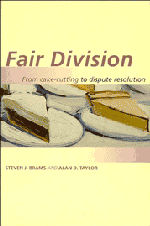Book contents
- Frontmatter
- Contents
- List of figures
- List of tables
- Acknowledgments
- Introduction
- 1 Proportionality for n = 2
- 2 Proportionality for n > 2: the divisible case
- 3 Proportionality for n > 2: the indivisible case
- 4 Envy-freeness and equitability for n = 2
- 5 Applications of the point-allocation procedures
- 6 Envy-free procedures for n = 3 and n = 4
- 7 Envy-free procedures for arbitrary n
- 8 Divide-the-dollar
- 9 Fair division by auctions
- 10 Fair division by elections
- 11 Conclusions
- Glossary
- Bibliography
- Index
6 - Envy-free procedures for n = 3 and n = 4
Published online by Cambridge University Press: 05 July 2011
- Frontmatter
- Contents
- List of figures
- List of tables
- Acknowledgments
- Introduction
- 1 Proportionality for n = 2
- 2 Proportionality for n > 2: the divisible case
- 3 Proportionality for n > 2: the indivisible case
- 4 Envy-freeness and equitability for n = 2
- 5 Applications of the point-allocation procedures
- 6 Envy-free procedures for n = 3 and n = 4
- 7 Envy-free procedures for arbitrary n
- 8 Divide-the-dollar
- 9 Fair division by auctions
- 10 Fair division by elections
- 11 Conclusions
- Glossary
- Bibliography
- Index
Summary
Introduction
Divide-and-choose, as we showed in section 1.2, assures each player of a piece of cake he or she perceives to be at least 1/2 the total (proportionality), no matter what the other player does. Because there are only two players, this means that each player can get what he or she considers to be a piece at least tied for largest. To provide this guarantee, however, the cutter must play “conservatively” by dividing the cake exactly in two, according to his or her valuation of it. That way, whatever piece the chooser selects, the cutter is assured of getting 1/2.
Although proportionality and envy-freeness are equivalent when there are only two players, this is not the case when there are more than two players. In extending envy-freeness to more than two players, we seek procedures wherein each player has a strategy that guarantees him or her a piece that is at least tied for largest, no matter what the other players do.
We showed in chapters 2 and 3 that none of the n-person proportional procedures is envy-free: while these procedures guarantee a player a piece of size at least 1/n, one or more of the players might think that another player received a larger piece. This was not the case for the two-person pointallocation procedures we analyzed in chapter 4 and applied in chapter 5, which are not only proportional – and, therefore, envy-free – but also equitable.
- Type
- Chapter
- Information
- Fair DivisionFrom Cake-Cutting to Dispute Resolution, pp. 115 - 128Publisher: Cambridge University PressPrint publication year: 1996



